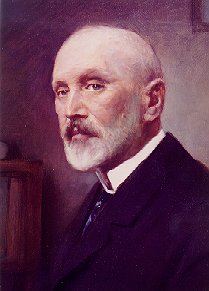<Back to Index>
- Physicist Loránd Eötvös de Vásárosnamény, 1848
- Poet Giosuè Alessandro Michele Carducci, 1835
- Duke of Milan Ludovico Sforza, 1452
PAGE SPONSOR

Baron Loránd Eötvös de Vásárosnamény (Hungarian: Vásárosnaményi Báró Eötvös Loránd or Loránd Eötvös; July 27, 1848 - April 8, 1919), more commonly called Baron Roland von Eötvös in the English literature, was a Hungarian physicist. He is remembered today largely for his work on gravitation and surface tension.
Born in 1848, the year of the Hungarian revolution, Eötvös was the son of József Eötvös, a well-known poet, writer, and liberal politician, who was cabinet minister at the time, and played an important part in 19th century Hungarian intellectual and political life.
Loránd Eötvös first studied law, but soon switched to physics and went abroad to study in Heidelberg and Königsberg. After earning his doctorate, he became a university professor in Budapest and played a leading part in Hungarian science for almost half a century. He gained international recognition first by his innovative work on capillarity, then by his refined experimental methods and extensive field studies in gravity.
Eötvös is remembered today for his experimental work on gravity, in particular his study of the equivalence of gravitational and inertial mass (the so-called weak equivalence principle) and his study of the gravitational gradient on the Earth's surface. The weak equivalence principle plays a prominent role in relativity theory and the Eötvös experiment was cited by Albert Einstein in his 1916 paper The Foundation of the General Theory of Relativity. Measurements of the gravitational gradient are important in applied geophysics, such as the location of petroleum deposits. The CGS unit for gravitational gradient is named the eotvos in his honor.
From 1886 until his death, Loránd Eötvös researched and taught in the University of Budapest, which in 1950 was renamed after him (Eötvös Loránd University).
Eötvös is buried in the Kerepesi Cemetery in Budapest, Hungary.
The Torsion or Eötvös balance, designed by Hungarian Baron Loránd Eötvös, is a sensitive instrument for measuring the density of underlying rock strata. The device measures not only the direction of force of gravity, but the change in the force of gravity's extent in horizontal plane. It determines the distribution of masses in the Earth's crust. The Eötvös torsion balance, an important instrument of geodesy and geophysics throughout the world, studies the Earth's physical properties. It is used for mine exploration, and also in the search for minerals, such as oil, coal and ores. One of his assistants who later would be famous was Radó von Kövesligethy. Eötvös' law of capillarity (weak equivalence principle) served as a basis for Einstein's theory of relativity. (Capillarity: the property or exertion of capillary attraction of repulsion, a force that is the resultant of adhesion, cohesion, and surface tension in liquids which are in contact with solids, causing the liquid surface to rise - or be depressed...)